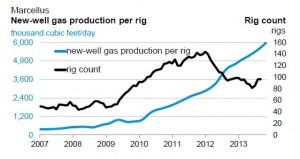Rig Count Down, Gas Output Up From the Article by Laura Legere, State Impact – PA, October 24, 2013 Improvements in drilling efficiency and increasing productivity from new wells are driving the recent growth in oil and gas production across six key shale regions in the country, including the Marcellus. In the first of what will be a monthly report on drilling productivity, the U.S. Energy Information Administration noted this week that “new technologies for drilling and producing natural gas and oil have made traditional measures of productivity, such as a simple count of active rotary drilling rigs, obsolete.” So the agency is using different measures to record productivity, especially an estimate of how much gas or oil is produced from new wells in a month per average rig operating in the region. The estimate indicates both the time it takes to drill a well and the well’s production, the agency said. A graph captures the trend in the Marcellus: fewer rigs are drilling new wells in the shale since a peak in early 2012, but the wells they drill are producing more gas at the start. The report held surprises for energy experts who did not expect the Marcellus Shale to reach its current output of more than 12 billion cubic feet of natural gas per day this year, or even for several years. According to the Associated Press: Federal energy experts are surprised by the rapid Marcellus growth, since the number of drilling rigs has fallen over the past two years. “A year ago, we were not expecting the Marcellus to be at 12 billion cubic feet,” said Sam Gorgen of the EIA, which is a part of the Department of Energy. The current Marcellus production is even higher than the predictions of Terry Engelder, a Penn State Universitygeologist who has drawn praise and criticism for his estimates of how much gas the region holds. Engelder had predicted that the Marcellus wouldn’t reach the 12 billion cubic foot rate until 2015, and some critics said that was overly optimistic. The report also shows production from the Marcellus and Haynesville shales diverging from a point of parity a year ago. Both shales were producing about 9.1 billion cubic feet of gas a day in November 2012, according to the EIA. Now, the Marcellus is expected to produce 12.6 billion cubic feet a day next month, while the Haynesville, which underlies parts of Louisiana, Texas and Arkansas, is expected to produce 6.6 billion cubic feet a day. See the new Drilling Productivity Report from the Energy Information Administration (EIA) here. |

